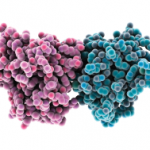Genetic variations also have a role in SLE, and mutations in multiple genes may contribute to the development of SLE, said Dr. Mohan.
Environmental Factors Tied to SLE
In his analysis of environmental factors, Dr. Mohan focused on the microbiome, smoking and the Epstein-Barr virus (EBV). Several studies show the gut microbiome is altered in both mice and humans with lupus. However, studies of the microbiome and SLE have been subject to multiple confounders, including diet, medications and disease activity, and identification of patient ethnicity, he explained.
Research focused on EBV and lupus finds a higher anti-EBV among patients with SLE, Dr. Mohan said. He cited a meta-analysis of 25 studies that found a statistically significant higher seroprevalence of EBV anti-viral capsid antigen IgG in SLE than controls. However, there was not a higher prevalence of anti-EBV nuclear antigen 1 antibodies.2 The meta-analysis supported the idea that EBV predisposes patients to develop lupus.
Dr. Mohan also shared results from a 2019 study that included 436 SLE patients’ relatives who did not initially have lupus and who were contacted again after 6.3 years.3 Upon the second contact, the relatives were evaluated for SLE. The mean baseline viral capsid antigen IgG and early antigen IgG levels were higher in relatives who developed SLE compared with relatives who were autoantibody negative and didn’t develop SLE. Jog et al. concluded that heightened serologic reactivation of EBV raises the possibility of transitioning to SLE in unaffected SLE relatives.
Dr. Mohan also discussed the role of smoking as it relates to lupus, sharing research that found current smokers and those smoking more than 10 pack-years were at higher risk for the disease.4
Speaker Disclosures
Dr. Mohan consults or has received funding from Pharmacyclics/AbbVie, Equillium and Progentec Diagnostics.
Vanessa Caceres is a freelance medical writer in Bradenton, Fla.
References
- Mobarrez F, Vikerfors A, Gustafsson JT, et al. Microparticles in the blood of patients with systemic lupus erythematosus (SLE): Phenotypic characterization and clinical associations. Sci Rep. 2016 Oct 25;6:36025.
- Hanlon P, Avenell A, Aucott L, et al. Systematic review and meta-analysis of the sero-epidemiological association between Epstein-Barr virus and systemic lupus erythematosus. Arthritis Res Ther. 2014 Jan 6;16(1):R3.
- Jog NR, Young KA, Munroe ME, et al. Association of Epstein-Barr virus serological reactivation with transitioning to systemic lupus erythematosus in at-risk individuals. Ann Rheum Dis. 2019 Sep;78(9):1235–1241.
- Barbhaiya M, Tedeschi SK, Lu B, et al. Cigarette smoking and the risk of systemic lupus erythematosus, overall and by anti-double stranded DNA antibody subtype, in the Nurses’ Health Study cohorts. Ann Rheum Dis. 2018 Feb;77(2):196–202.

